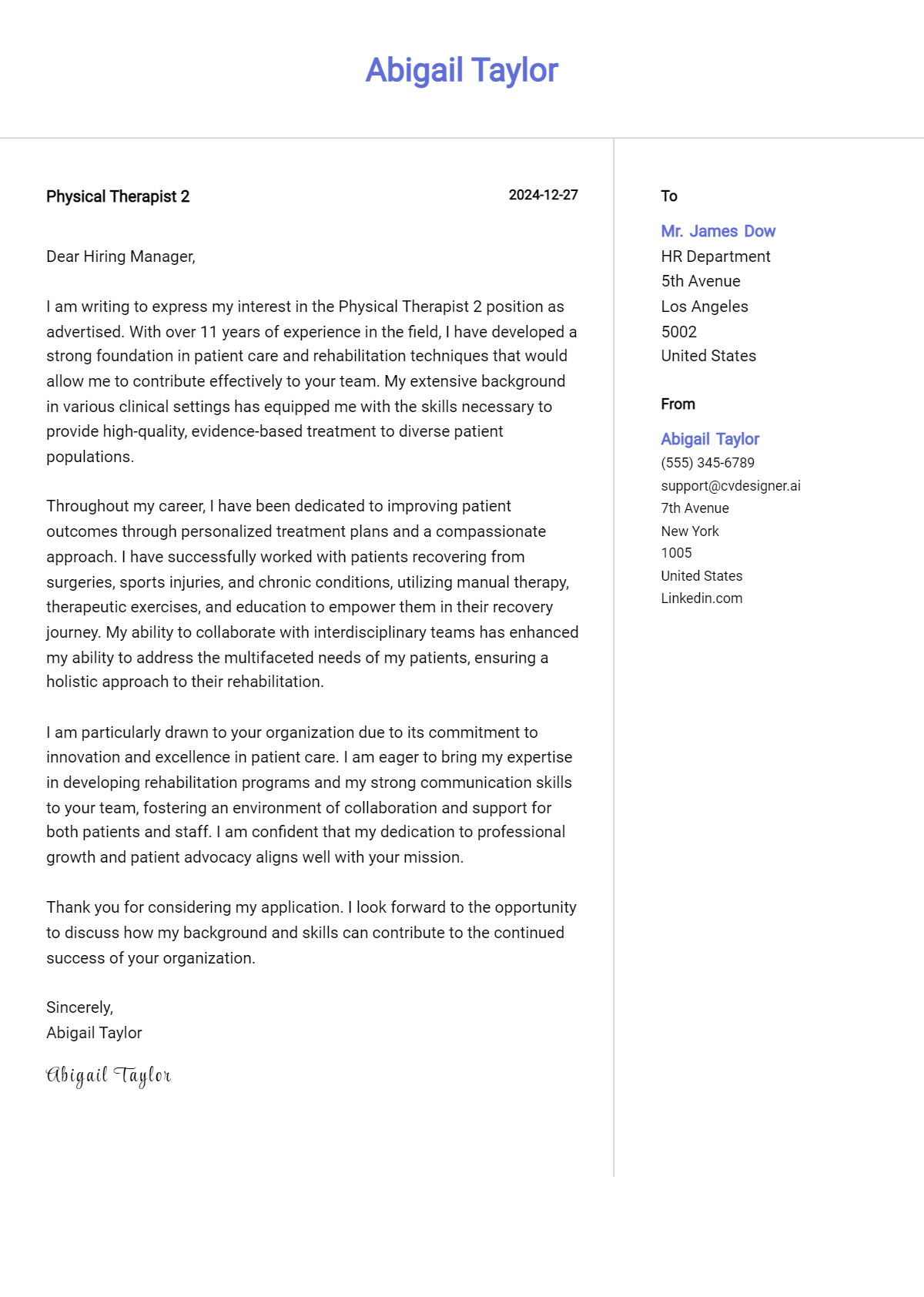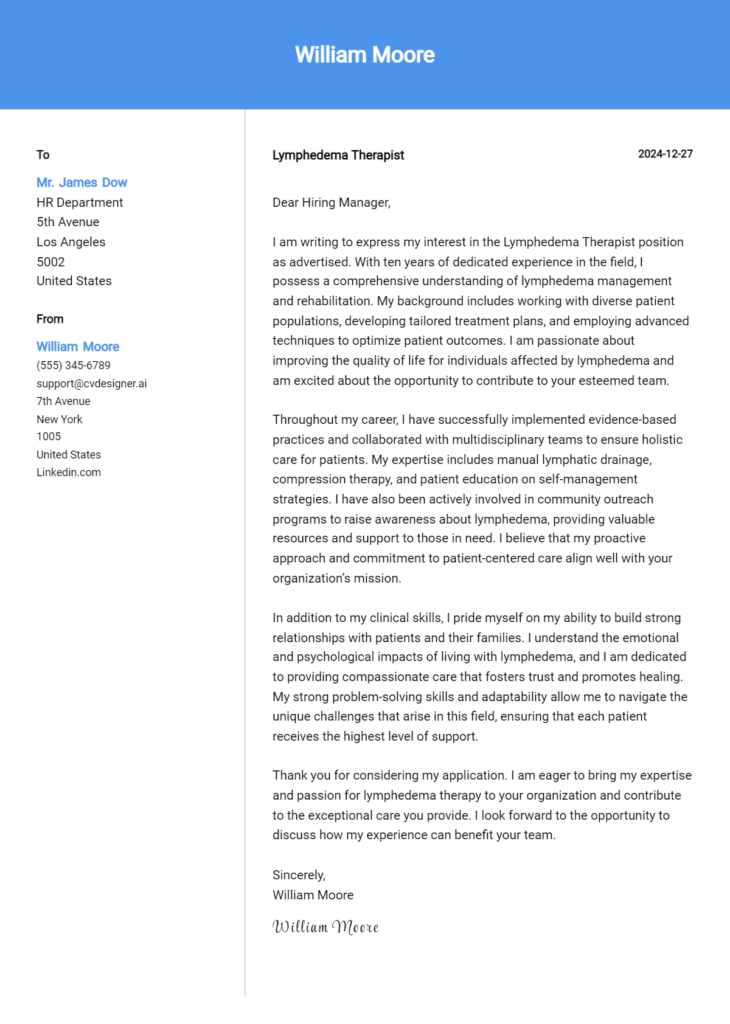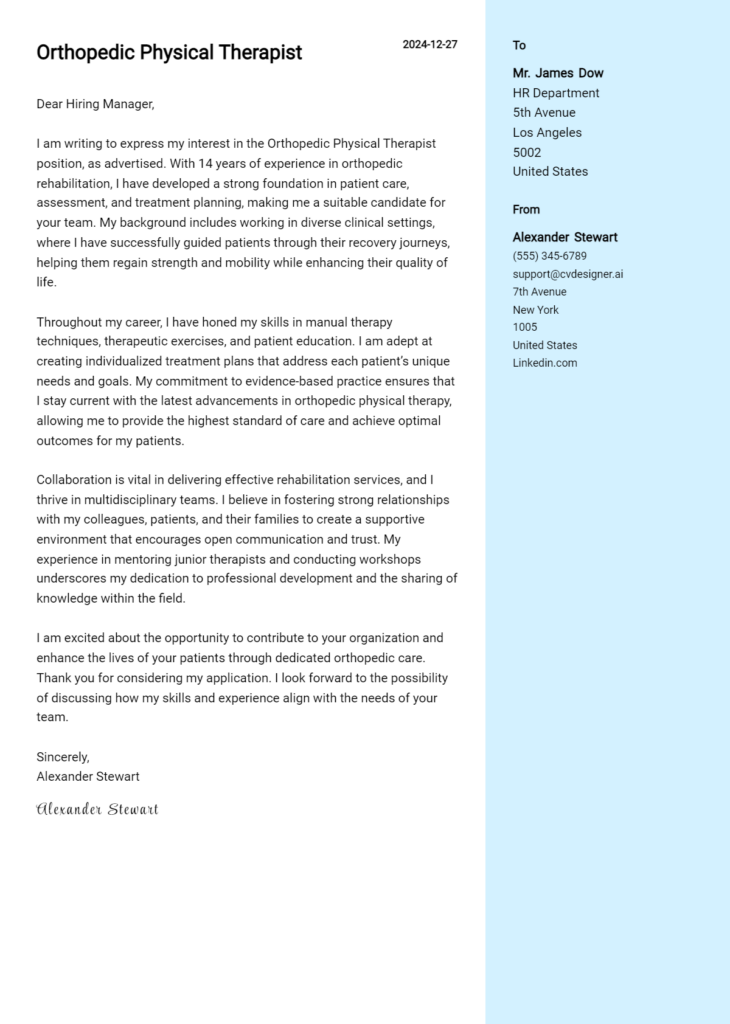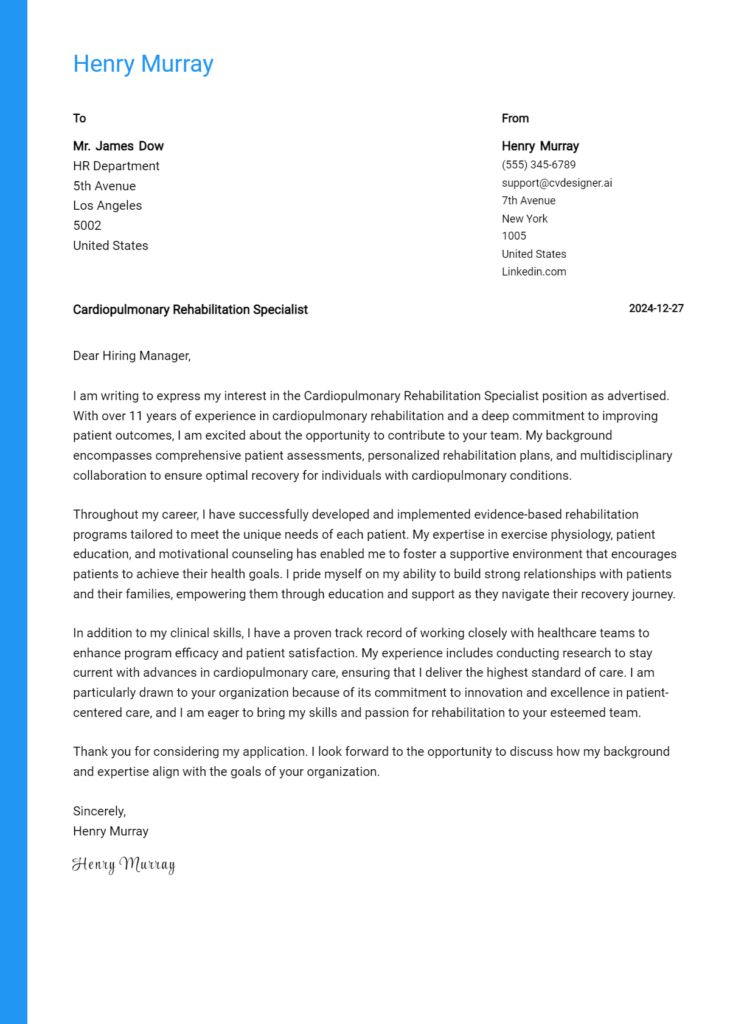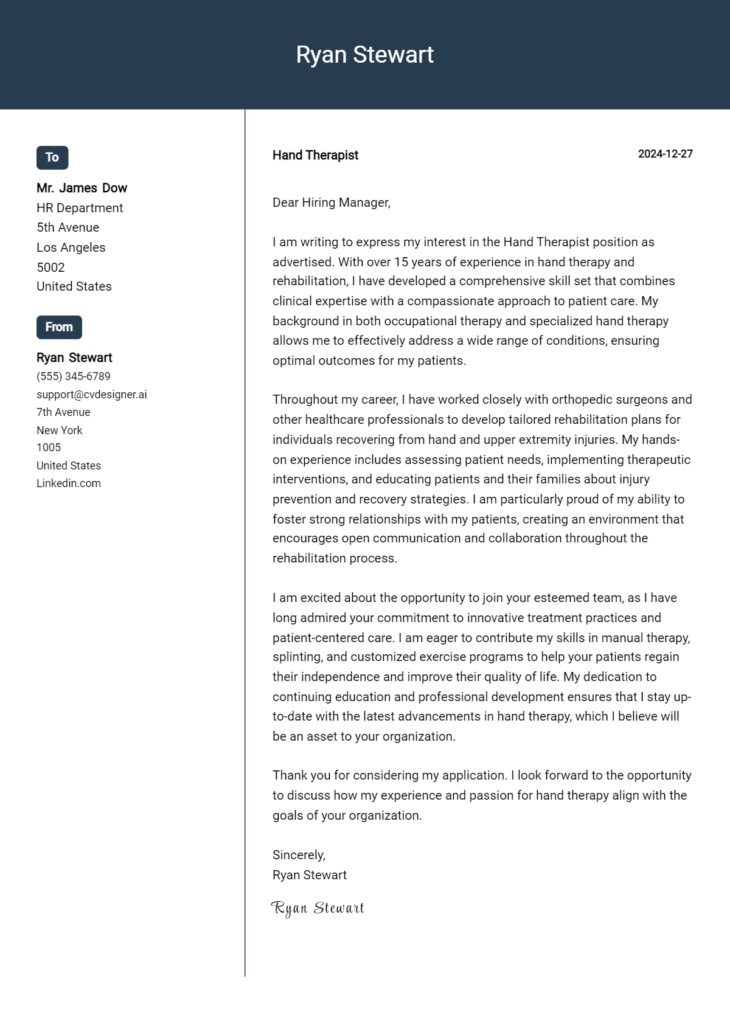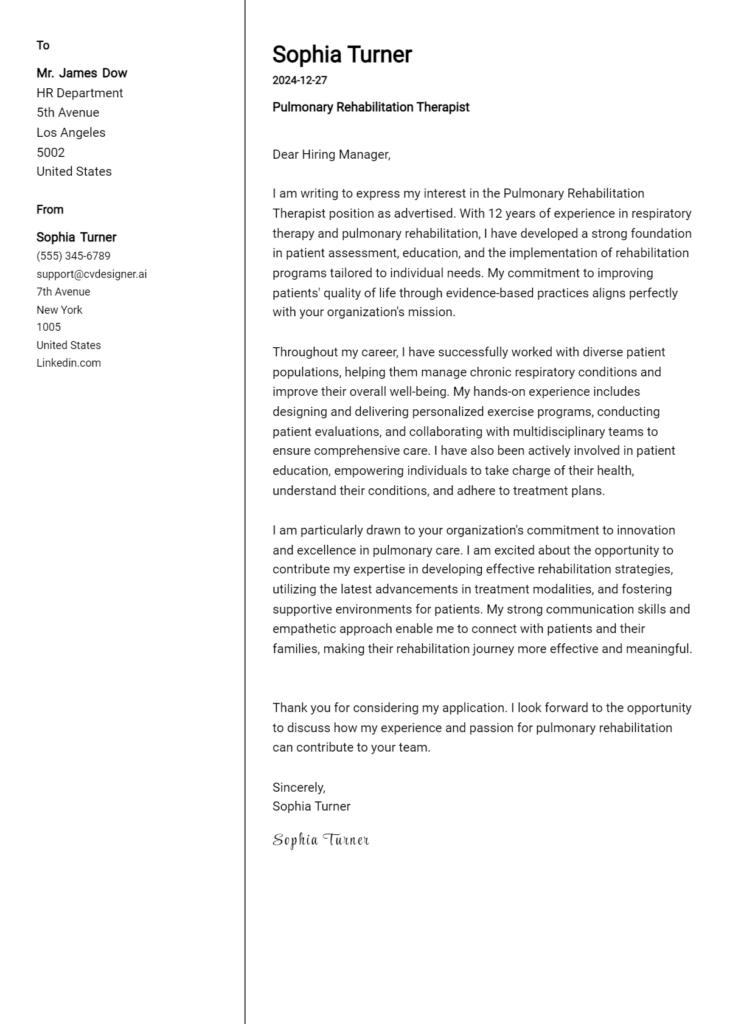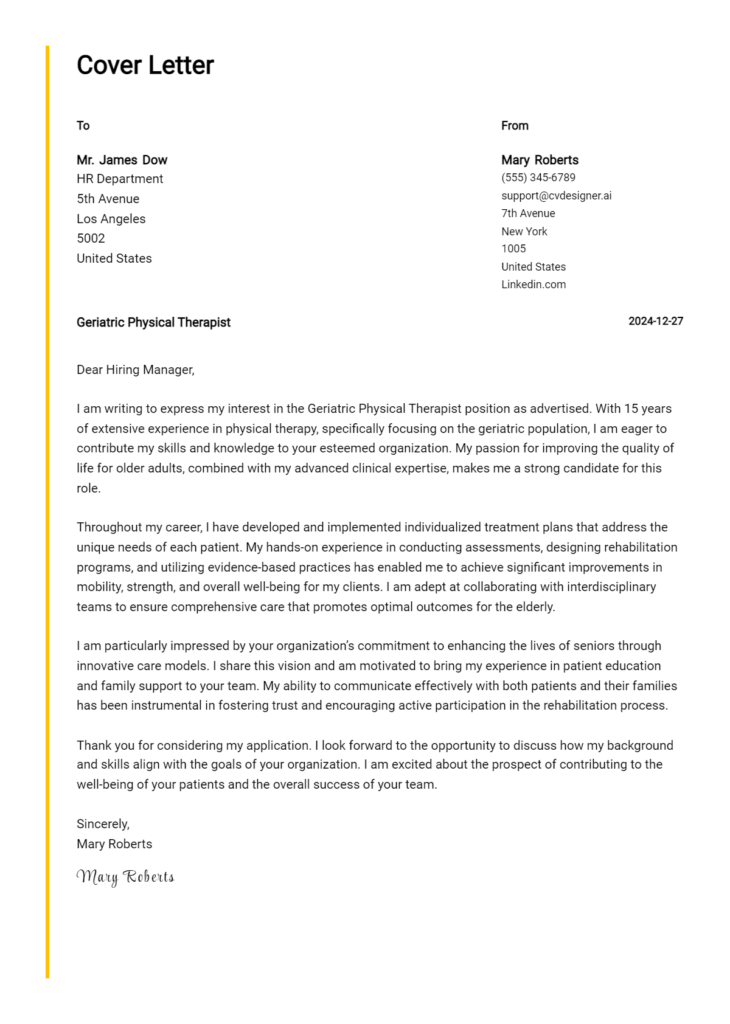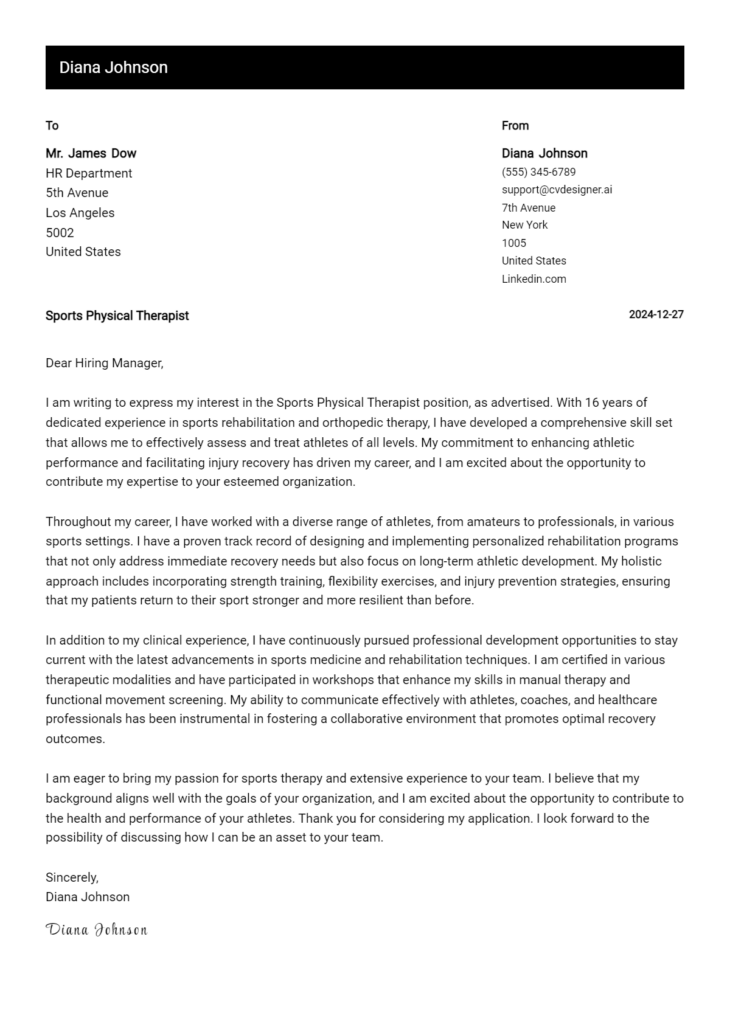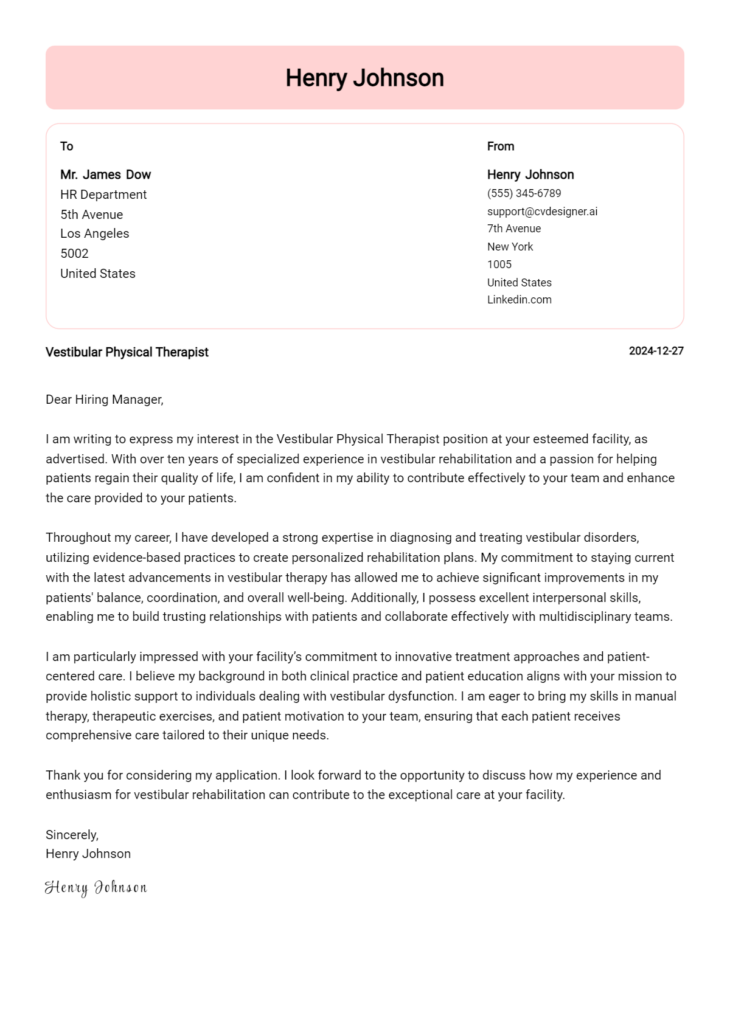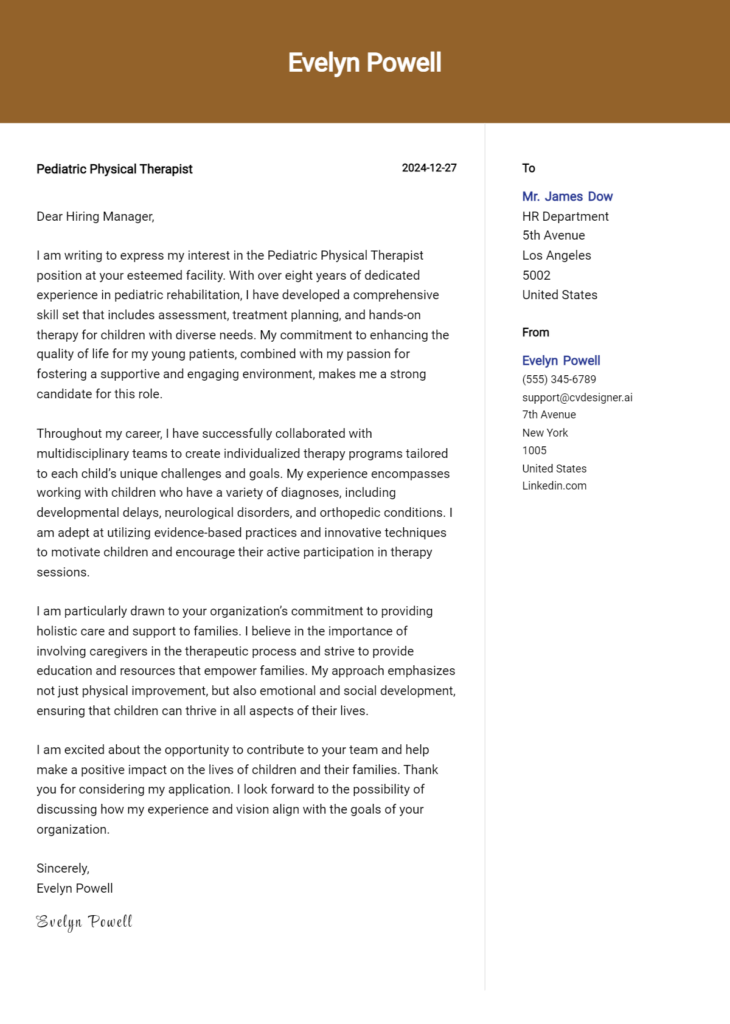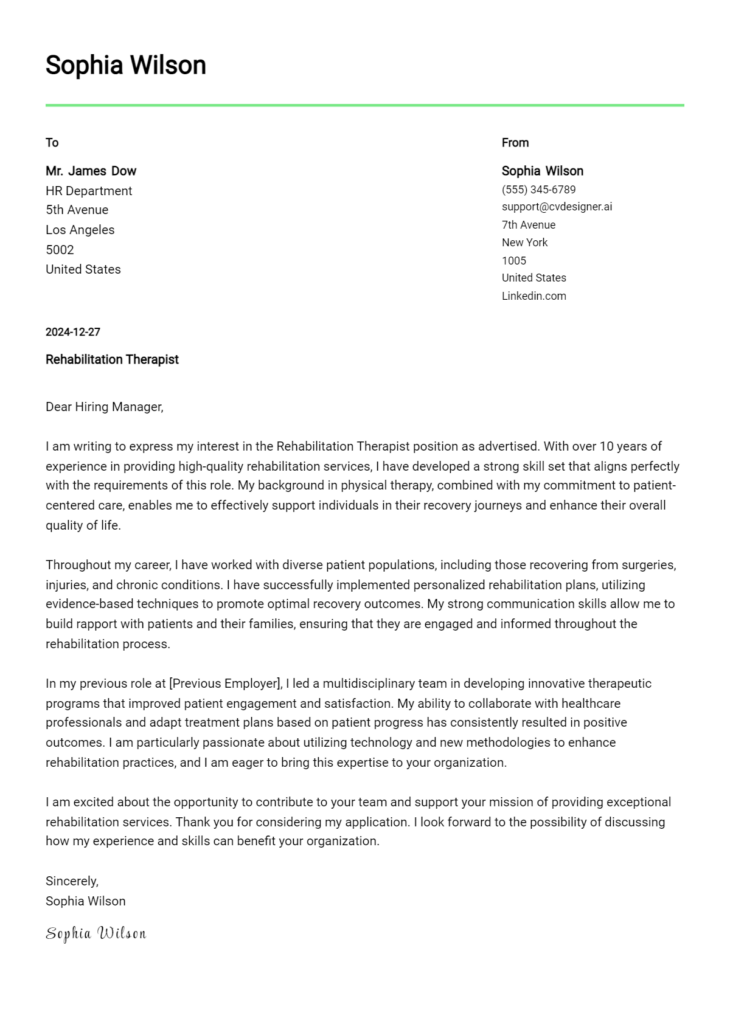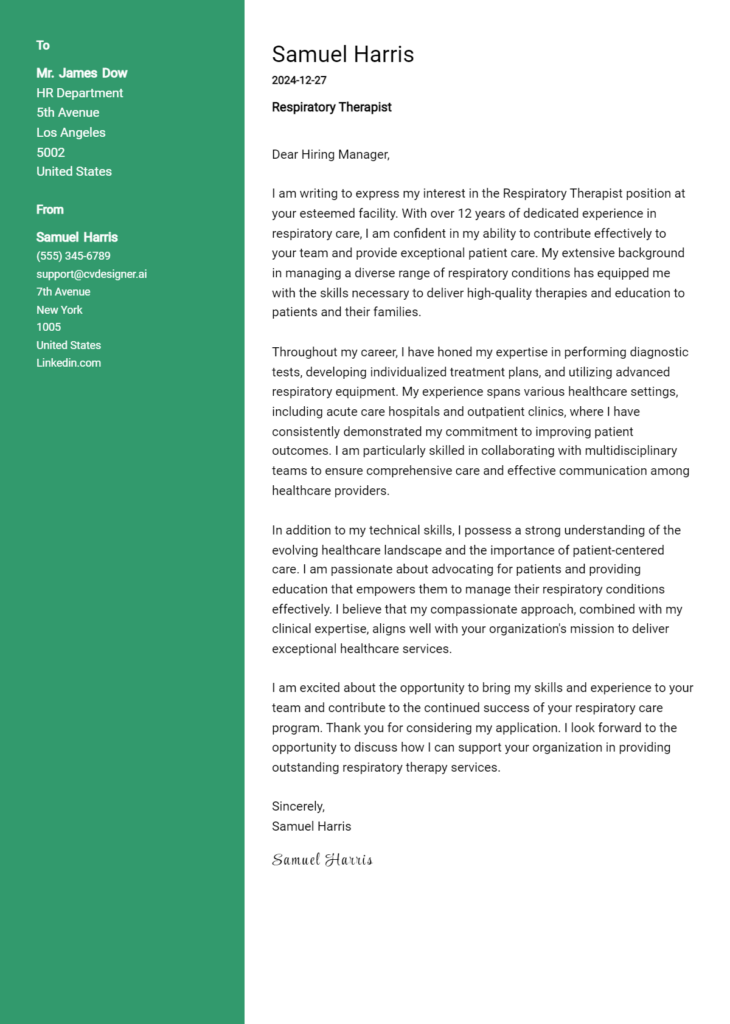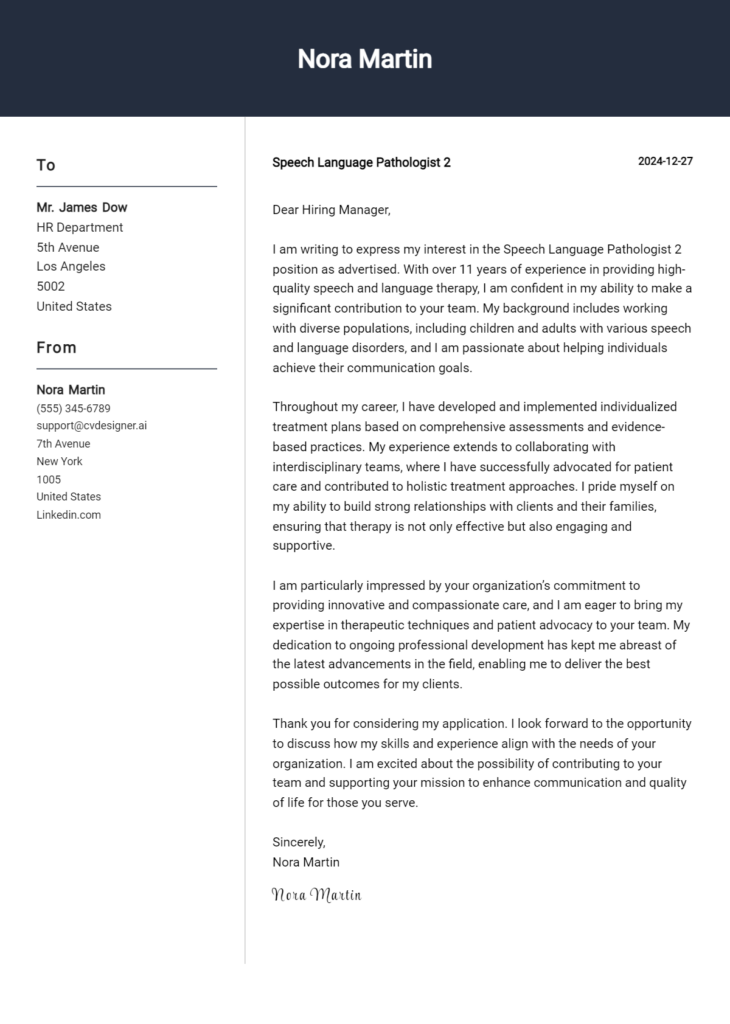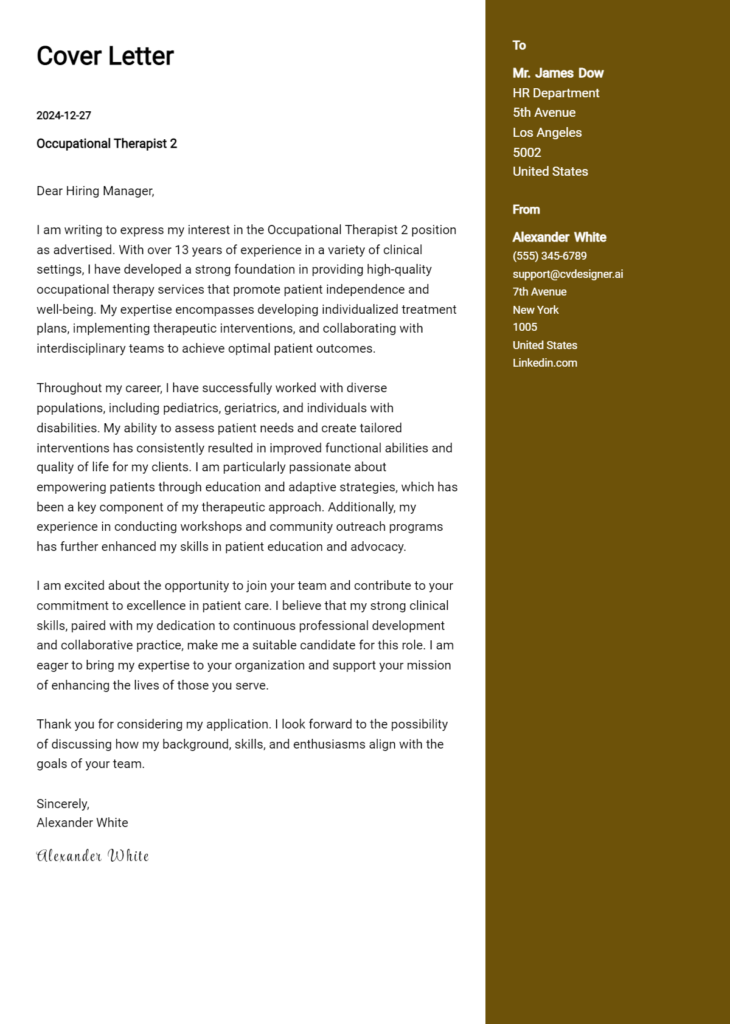Physical Therapist 2 Cover Letter Examples
Explore additional Physical Therapist 2 cover letter samples and guides and see what works for your level of experience or role.
How to Format a Physical Therapist Cover Letter?
Crafting a compelling cover letter is essential for Physical Therapists, as it serves as your first opportunity to make a lasting impression on potential employers. The way you format your cover letter not only reflects your professionalism but also communicates your ability to engage with patients and colleagues effectively. A well-structured cover letter can highlight your clinical skills, empathy, and dedication to patient care—traits that are vital in the physical therapy field.
In this guide, we will delve into the key components of a standout physical therapist cover letter, providing insights and examples tailored specifically for this profession.
We’ll focus on the essential elements of a professional cover letter, including:
- Cover Letter Header
- Cover Letter Greeting
- Cover Letter Introduction
- Cover Letter Body
- Cover Letter Closing
Each section is crucial in emphasizing your qualifications and commitment to the role. Let’s break down each part and explore how to make your physical therapist cover letter shine.
Importance of the Cover Letter Header for a Physical Therapist
The cover letter header is a crucial element of your application as a Physical Therapist, as it sets the tone for your professionalism and attention to detail. A well-structured header provides essential information that allows the recipient to identify you quickly and reach you easily. It should include your contact information, the date, and the recipient's details, such as their name, title, and the organization. Clarity and professionalism in the header reflect your organizational skills and respect for the hiring process, making a positive first impression on potential employers.
Strong Example
Jane Doe 123 Main Street City, State, Zip Code Email: janedoe@email.com Phone: (123) 456-7890 October 1, 2023 Mr. John Smith Hiring Manager Physical Therapy Clinic 456 Business Rd City, State, Zip Code
Weak Example
jane doe 123 main st email: janedoe@email.com 10/1/23 To whom it may concern:
The Importance of the Cover Letter Greeting
The greeting of a cover letter is a critical component that sets the tone for the entire document. A well-crafted greeting not only demonstrates professionalism but also adds a personal touch by directly addressing the hiring manager. This approach helps to create an immediate connection, signaling that the applicant has taken the time to research and engage with the organization. Avoiding generic greetings, such as "To Whom It May Concern," is essential, as they can make the letter feel impersonal and disengaged. Instead, when possible, take the time to find out the name of the hiring manager or recruiter and use it in the greeting. This small effort can significantly enhance the impression you make.
Here are some examples of strong and weak greetings for a Physical Therapist cover letter:
Strong Greeting Example
Dear Ms. Johnson,
Weak Greeting Example
To Whom It May Concern,
Importance of a Well-Crafted Cover Letter Introduction for a Physical Therapist
A well-crafted cover letter introduction is crucial for a Physical Therapist seeking to make a positive impression on a hiring manager. This opening paragraph serves as the first opportunity to capture attention, convey enthusiasm for the role, and provide a glimpse of the candidate's relevant skills and achievements. An engaging introduction not only sets the tone for the rest of the cover letter but also helps establish a connection with the reader, making them more inclined to continue reading. Below are examples of strong and weak introductions that illustrate the impact of a well-written opening.
Strong Example
Dear [Hiring Manager's Name], As a dedicated Physical Therapist with over five years of experience in rehabilitation settings, I am excited to apply for the position at [Company Name]. I have successfully helped clients regain their mobility and improve their quality of life through individualized treatment plans and evidence-based practices. My passion for patient care, combined with my proficiency in manual therapy techniques, positions me as a strong candidate to contribute to your team and support your mission of enhancing patient outcomes.
Weak Example
To Whom It May Concern, I am writing to apply for the Physical Therapist position. I have a degree in Physical Therapy and some experience. I think I would be a good fit for the job, and I hope to hear back from you.
Purpose of the Cover Letter Body for a Physical Therapist
The body of a cover letter for a Physical Therapist serves as a critical platform for showcasing the candidate's unique skills, relevant experiences, and the overall value they bring to the organization. It is an opportunity to connect specific qualifications to the job requirements, demonstrating how past projects and accomplishments align with the prospective employer’s goals. By detailing experiences such as successful rehabilitation programs, patient success stories, or collaborative efforts with healthcare teams, candidates can illustrate their ability to contribute positively to patient care and the workplace environment.
Strong Example
Dear Hiring Manager, I am excited to apply for the Physical Therapist position at XYZ Rehabilitation Center. With over five years of experience in outpatient settings, I have successfully implemented individualized treatment plans that resulted in a 30% increase in patient recovery rates. For example, I developed a community outreach program focused on injury prevention, which not only educated over 200 participants but also reduced sports-related injuries in the local high school by 15% during the last academic year. My collaborative approach and commitment to patient-centered care make me a strong fit for your team. Sincerely, Jane Doe
Weak Example
Dear Sir or Madam, I am writing to apply for the Physical Therapist job. I have worked in the field for a while and have seen many patients. I think I would be a good fit for your company because I like helping people. I have done some things in my past jobs, but I can't remember the details right now. I hope to bring my skills to your team. Best, John Smith
Importance of the Cover Letter Closing for a Physical Therapist
The closing paragraph of a cover letter is crucial for a Physical Therapist as it allows the candidate to summarize their qualifications, reiterate their enthusiasm for the position, and encourage the hiring manager to take the next steps, such as reviewing their resume or scheduling an interview. A strong closing can leave a lasting impression and motivate the employer to reach out, while a weak closing may diminish the impact of the entire letter.
Strong Example
Thank you for considering my application for the Physical Therapist position at [Company Name]. With my extensive background in orthopedic rehabilitation and a passion for patient-centered care, I am excited about the opportunity to contribute to your team. I believe my skills and dedication align perfectly with your mission to enhance patient recovery and well-being. I look forward to the possibility of discussing how my experience can benefit your practice. Please feel free to contact me at your earliest convenience to schedule an interview. Thank you once again for your time and consideration.
Weak Example
I hope you like my application. I think I would be good for the Physical Therapist job. Please look over my resume. Let me know if you want to talk.
Common Mistakes to Avoid in a Physical Therapist Cover Letter
Avoiding common mistakes in your cover letter is crucial for standing out in the competitive field of physical therapy. A well-crafted cover letter can be your ticket to an interview, while careless errors may lead to immediate disqualification. Here are some common pitfalls to watch out for:
Generic Greetings: Using "To Whom It May Concern" can make your cover letter feel impersonal. Always try to address the hiring manager by name. Research the company to find the right contact.
Lack of Specificity: Failing to tailor your letter to the specific job or institution shows a lack of genuine interest. Use the job description to highlight relevant experiences and skills that align with the position.
Overcomplicating the Format: Using an overly complex layout can distract from your content. Stick to a clean and professional cover letter format that enhances readability.
Being Too Formal or Informal: Striking the right tone is essential. Avoid overly casual language, but also steer clear of stiff, formal phrases that may seem inauthentic.
Neglecting to Showcase Achievements: Simply listing duties from past roles is insufficient. Instead, focus on quantifiable achievements that demonstrate your impact as a physical therapist.
Typos and Grammatical Errors: Errors can undermine your professionalism. Proofread your letter multiple times and consider using tools or asking a colleague to review it.
Ignoring the Call to Action: Failing to express your enthusiasm for an interview can leave a weak impression. Conclude with a confident statement inviting further conversation.
By being mindful of these common mistakes and utilizing resources like cover letter examples, you can create a compelling cover letter that showcases your qualifications effectively.
Cover Letter FAQs for Physical Therapist
What should I include in my cover letter as a Physical Therapist?
Your cover letter should begin with a strong opening that captures the reader's attention. Include your contact information at the top, followed by the date and the employer's details. In the body, introduce yourself and clearly state the position you're applying for. Highlight your relevant qualifications, such as your degree, licensure, and any specialized training. Discuss your experience in different settings, like outpatient clinics or rehabilitation facilities, and mention specific skills that align with the job requirements. Finally, express your enthusiasm for the role and the organization, and conclude with a professional closing.
How can I tailor my cover letter for a specific Physical Therapist position?
To tailor your cover letter, start by researching the employer and understanding their mission, values, and the specific requirements of the job. Use keywords from the job description to align your skills and experiences with what the employer is seeking. For example, if the position emphasizes manual therapy, mention your training and experience in that area. Additionally, refer to any unique attributes of the facility, like a focus on sports rehabilitation or geriatric care, and explain how your background makes you an ideal fit. Personalizing your letter demonstrates your genuine interest in the role.
Should I include my clinical experiences in my Physical Therapist cover letter?
Yes, including your clinical experiences is crucial in a Physical Therapist cover letter. This is your opportunity to showcase your hands-on skills and knowledge gained through internships, residencies, or previous employment. Highlight specific cases or populations you've worked with, as well as any techniques or modalities you are proficient in. For example, you might mention your experience with post-surgical rehabilitation or your success in implementing exercise programs for chronic pain management. Be sure to quantify your achievements whenever possible, as this adds credibility to your experiences and illustrates your effectiveness as a clinician.
What tone should I use in my cover letter for a Physical Therapist position?
The tone of your cover letter should be professional yet warm, reflecting your personality and passion for patient care. Use clear and concise language, avoiding jargon unless it directly relates to the job. Balance professionalism with a friendly demeanor to convey your approachability as a therapist. It's important to express enthusiasm for the position and the organization while maintaining a respectful tone. Personal anecdotes or brief stories about your experiences can help illustrate your qualifications and make your letter more engaging. Ultimately, the goal is to connect with the reader while showcasing your expertise and dedication to the field.
Build your Cover Letter in minutes
Use an AI-powered cover letter builder and have your letter done in 5 minutes. Just select your template and our software will guide you through the process.

